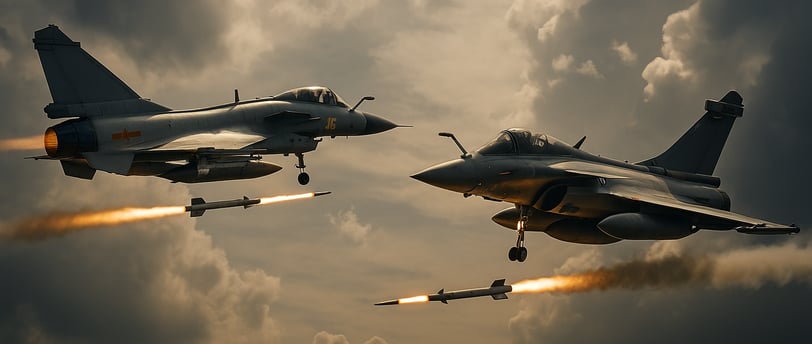India-Pakistan War 2025: The Pahalgam Attack and Aerial Clashes
Explore the 2025 India-Pakistan conflict in detail — from the deadly Pahalgam shooting to Pakistan's downing of five Indian jets, including three Rafales. Get verified facts, expert insights, and global reactions to South Asia's most dangerous escalation in years.
5/11/20253 min read


Introduction to the 2025 India-Pakistan War
The 2025 India-Pakistan War marks a significant moment in South Asian history, characterized by deeply rooted tensions between the two nations. Historical conflicts, particularly over the Kashmir region, have perpetuated hostilities, fueling animosities that date back to the partition of British India in 1947. This territorial dispute has catalyzed numerous clashes and wars, making the prospect of peace elusive and fraught with challenges. The war in 2025 serves as a culmination of escalating tensions and failures in diplomatic resolutions.
The immediate build-up to the conflict can be traced to a series of provocative incidents, including cross-border skirmishes and heightened military posturing by both countries. In the lead-up to the war, both nations experienced a surge in nationalistic fervor, which was further amplified by inflammatory rhetoric from political leaders. This charged atmosphere contributed to the breakdown of dialogue, leading to an environment ripe for conflict. Additionally, various non-state actors contributed to the instability, reflecting the complex geopolitical dynamics in the region.
The war is characterized by notable incidents, such as the Pahalgam attack, which galvanized public opinion and mobilized military responses from both sides. Furthermore, the aerial clashes symbolized not just combat engagements but a shift in military strategy, reflecting technological advancements in warfare. The strategies employed during this war underscored the dangers of miscalculation and the rapid escalation of military responses in an age defined by sophisticated weaponry.
In essence, the 2025 India-Pakistan War represents more than a mere conflict; it encapsulates the historical grievances, evolving military tactics, and the persistent quest for territorial and political supremacy in South Asia. This war is hence regarded as a pivotal event that will shape the future of regional dynamics and international relations in the years to come.
The 2025 India-Pakistan Conflict: A New Chapter in South Asian Tensions
The fragile peace between nuclear-armed neighbors India and Pakistan shattered once again in April 2025, sparking one of the most dangerous escalations in the region since the 2019 border skirmishes. Triggered by a deadly terrorist attack in Indian-administered Kashmir, the conflict quickly escalated into direct military exchanges, aerial dogfights, and cross-border strikes—drawing international concern and unprecedented scrutiny.
The Spark: Kashmir Attack
On April 22, 2025, a suicide bombing in Kashmir claimed the lives of 26 civilians. India swiftly blamed Pakistan-based militant groups for the attack and vowed retaliation which Pakistan denied. Within days, the Indian Air Force launched targeted airstrikes on Pakistani military installations near Rawalpindi.
The boldness of India’s move stunned observers and triggered an immediate and forceful Pakistani military response.
Pakistan’s Retaliation: High Stakes, High Precision
Pakistan responded with a series of aerial and artillery strikes along the Line of Control and into Indian airspace. According to multiple credible international sources, including Reuters, Le Monde, and The Washington Post, Pakistan's Chinese-made JF-17 Thunder and J-10C fighter jets engaged Indian aircraft in a tense and complex aerial battle.
The Dogfight: Pakistan Downs 5 Indian Jets
Pakistan’s military claims—and U.S. intelligence sources reportedly confirm—that during these aerial engagements:
5 Indian jets were downed, including
3 French-made Rafale fighters,
1 Su-30MKI, and
1 Mirage 2000.
The reported loss of Rafale jets was particularly significant. These were considered among the most advanced in India’s arsenal and had never before been lost in combat. This development raised questions about not only India's air defense strategy but also the performance of these high-cost, high-tech platforms in real-world conflict scenarios.
Visual evidence of debris was confirmed by satellite imagery analysts and international media outlets, although India has publicly denied losing any Rafales, calling the viral images "misleading" and "unrelated."
Casualties and Consequences
Though both sides claim to have exercised "restraint," the conflict resulted in:
Dozens of soldiers killed on both sides,
Civilian casualties in border villages,
Temporary airspace closures,
And rising fears of a broader war—especially given the proximity of strikes to nuclear facilities.
Despite a ceasefire announced on May 10, 2025, brokered by the U.S., the truce has been shaky, with repeated violations reported from both sides within days.
Diplomatic Fallout and Global Reactions
Vice President JD Vance of the United States initially stated that the conflict was “none of our business,” only to reverse course days later as Washington mediated an urgent ceasefire. China, Russia, and the UN all called for restraint, while Turkey and Saudi Arabia expressed support for de-escalation.
The conflict highlighted the continued volatility of South Asia, and the inability of international mechanisms to prevent escalation between two nuclear-armed adversaries.
A Dangerous New Normal?
The 2025 conflict reaffirms the unpredictable and volatile nature of India-Pakistan relations. It raises serious questions:
Are current deterrence strategies outdated?
Is a conventional war between nuclear powers now more likely?
Can international diplomacy keep pace with fast-moving crises in a hyper-connected world?
As tensions remain high, the region—and the world—must ask: are we on the brink of something far more dangerous, or can diplomacy still pull South Asia back from the edge?
